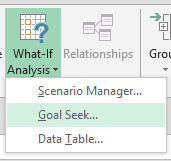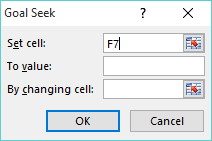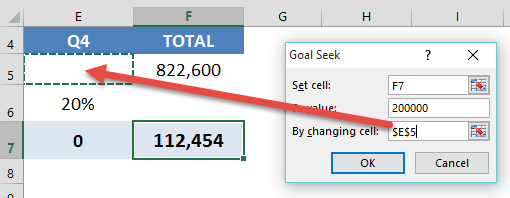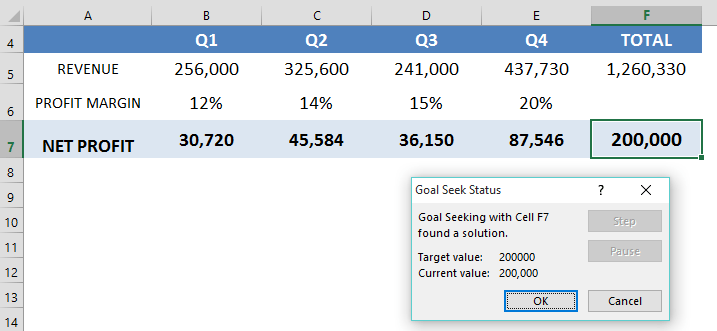Every business faces ups and downs. Sales might soar in some quarters and dip in others. But what happens when a critical quarter underperforms and threatens your annual profit goal? This is where Excel can save the day with its Goal Seek feature. Goal Seek is a simple yet powerful tool that allows you to work backward—setting a target and letting Excel calculate the input needed to hit that target.
In this article, we’ll explore how to use Excel Goal Seek to determine the sales you need in a final quarter to meet a net profit goal. We’ll use a practical example, breaking it down step by step.
Key Takeaways:
- Goal Seek works backward: It calculates the input needed to reach a desired result in a formula.
- Only one variable at a time: Goal Seek adjusts a single input value to hit your target.
- Formula-based requirement: The target cell must contain a formula for Goal Seek to function.
- Saves time and increases precision: It eliminates trial-and-error and provides exact numbers for decision-making.
- Flexible and practical: You can use Goal Seek for sales, expenses, break-even points, or any formula-driven scenario.
Download excel workbookGoal-Seek-Budget-Values.xlsx
Table of Contents
Understanding Excel Goal Seek and Its Advantages
What is Excel Goal Seek?
Goal Seek is part of Excel’s What-If Analysis tools. Essentially, it lets you:
- Set a desired result for a formula
- Adjust one input value to achieve that result
Think of it as telling Excel, “I want this final number to be X—what should I change to make it happen?” In our scenario, the desired result is a Net Profit of $200,000, and the input value we can control is the Q4 Sales forecast.
Why Goal Seek is Powerful
- Saves Time: No need for manual trial-and-error calculations.
- Precise: Gives exact values needed to meet a target.
- Flexible: Works with any formula-based cell, not just profit calculations.
- Dynamic: You can run multiple scenarios by changing inputs like costs, pricing, or sales volume.
- Simple to Use: No advanced Excel knowledge required.
Step-by-Step: Using Goal Seek to Hit Your Profit Goal
STEP 1: Select the cell that you want to achieve your goal of $200,000, which is the Total Net Profit in cell F7, which is a Sum formula (Important: This cell must be a formula for the Goal Seek to work)
STEP 2: Go to Data > What If Analysis > Goal Seek
STEP 3: SET CELL: This is the cell that contains the goal we want to achieve, F7, and is selected automatically
STEP 4: TO VALUE: Type the goal value that you want to achieve. In our example, it will be 200,000
STEP 5: BY CHANGING CELL: Enter the reference for the cell that contains the input value that you want to adjust. In our example it is the Q4 Sales forecast in cell E5
STEP 6: Press OK and Goal Seek will run and produce a result. Press OK to keep the results or Cancel to discard
With Goal Seek, we need to achieve Q4 Sales of $437,730 in order to achieve our Net Profit goal of $200,000. Over to the Sales team, then to make it happen!
Practical Tips for Using Goal Seek
While Goal Seek is simple, here are some tips to make it more effective:
- Always Use Formulas: Ensure your target cell is formula-based; otherwise, Goal Seek will fail.
- Single Input Only: Goal Seek works with one changing cell at a time. For multiple variables, use Solver, another Excel tool.
- Check Feasibility: If the required input value is unrealistic (like negative sales or astronomical figures), re-evaluate assumptions.
- Use Named Ranges: Using named ranges for key cells improves clarity when setting up Goal Seek.
- Document Results: Always keep a note of the Goal Seek scenario for future reference or presentations.
FAQs
1. Can Goal Seek work without a formula in the target cell?
No, Goal Seek requires the target cell to have a formula. Without a formula, Excel cannot determine how to adjust inputs to reach the desired result. You must sum or calculate your target value using standard Excel formulas, such as SUM or PRODUCT. Once the formula is in place, Goal Seek can run successfully. Always check the target cell before starting Goal Seek, because even minor errors in formulas can lead to incorrect or impossible results. This ensures that the analysis is accurate and reliable for decision-making.
2. Can Goal Seek handle multiple input variables at once?
No, Goal Seek can adjust only one input variable at a time. If you need to change multiple inputs to meet a goal, Excel’s Solver tool is more appropriate. Solver allows optimization based on multiple constraints and can handle complex scenarios, such as balancing costs and sales simultaneously. For simple single-variable scenarios, Goal Seek is faster and easier. Using Goal Seek first can often help identify which variable has the biggest impact before moving to more advanced tools like Solver.
3. What kind of problems is Goal Seek best for?
No, Goal Seek can adjust only one input variable at a time. If you need to change multiple inputs to meet a goal, Excel’s Solver tool is more appropriate. Solver allows optimization based on multiple constraints and can handle complex scenarios, such as balancing costs and sales simultaneously. For simple single-variable scenarios, Goal Seek is faster and easier. Using Goal Seek first can often help identify which variable has the biggest impact before moving to more advanced tools like Solver.
4. How do I know if the Goal Seek result is realistic?
After Goal Seek produces a solution, always review it for feasibility. Check if the calculated input is achievable, such as realistic sales targets or expense reductions. Unrealistic results may indicate flawed assumptions or errors in your formulas. Adjust assumptions if needed and rerun Goal Seek. This ensures the solution is practical for decision-making.
5. Can Goal Seek results be saved or documented?
Yes, after running Goal Seek, you can choose OK to keep the results or Cancel to discard them. It’s recommended to document your Goal Seek scenarios for future reference. This helps track what assumptions were used and how targets were achieved. You can also save the workbook version for scenario comparison. Documentation is key to transparent business planning.
John Michaloudis is a former accountant and finance analyst at General Electric, a Microsoft MVP since 2020, an Amazon #1 bestselling author of 4 Microsoft Excel books and teacher of Microsoft Excel & Office over at his flagship MyExcelOnline Academy Online Course.














